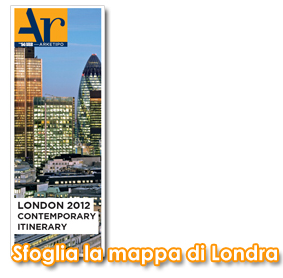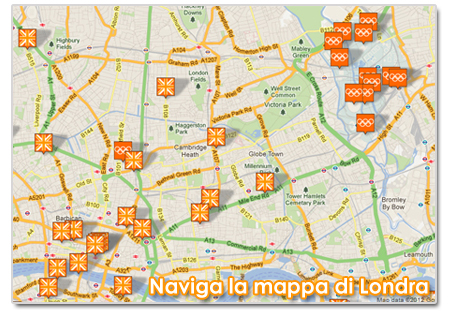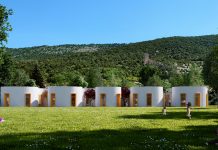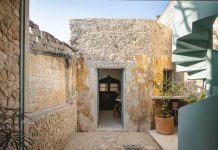Una copertura, costituita da funi di acciaio tensionate all'interno della trave reticolare di bordo e rivestita con pannelli di legno, assume un andamento curvo che rispecchia la pista all'interno. È interrotta solo da otto nastri di lucernari che riducono il fabbisogno di luce artificiale durante gli allenamenti. Progettato da Hopkins Architects per ospitare 6.000 persone e realizzato in soli 23 mesi, grazie al lavoro di 450 operai sul cantiere e di 2.500 lavoratori nel corso del progetto, il velodromo di Londra è la prima struttura finita fra quelle previste nel costruendo Parco Olimpico. Esso sorge nella parte settentrionale dell'area olimpica ed è progettato per essere permanente. Terminata la manifestazione, il velodromo sarà utilizzato da atleti professionisti e dalla comunità locale offrendo, oltre agli impianti sportivi, un centro per il noleggio delle biciclette, officine e una caffetteria. L'edificio è caratterizzato dalla copertura di legno e metallo che, con la sua forma elegantemente curva, rispecchia quella della pista da corsa. Un "guscio" che ospita il secondo anello delle tribune, separato dal basamento seminterrato (che racchiude la pista da corsa, i locali di servizio e il primo ordine di spalti) tramite un collegamento vetrato che garantisce la continuità visiva tra interno ed esterno e lo fa apparire sospeso. La forma a sella del guscio-copertura, a doppia curvatura, dà origine a un corpo di fabbrica compatto, di notevole altezza (22 m), caratterizzato da un forte aggetto che il rivestimento di facciata in doghe di legno contribuisce a enfatizzare. Essa è stata messa a punto valutando diverse soluzioni e verificando l'interazione fra struttura portante e forma della copertura e dell'arena, in rapporto ai tempi di realizzazione e ai costi, economici ed energetici, durante l'intero ciclo di vita dell'edificio. La soluzione strutturale finale è costituita da un reticolo di funi di acciaio tensionate che trasmette le forze di trazione nella trave reticolare di bordo, sempre di acciaio. Essa è stata scelta soprattutto per la sua leggerezza: 70 kg/mq soltanto (comprensivi dei cavi, della struttura metallica ad anello che regge la copertura e gli spalti, dei pannelli di chiusura di legno e delle finiture), con un risparmio di circa 1.000 tonnellate di acciaio rispetto a una struttura convenzionale. I pannelli di legno con tipologia a cassetta, che formano la superficie del tetto e il sostegno per l'isolamento termico e il manto di copertura di alluminio, sono appoggiati sugli snodi della tensostruttura, ogni 3,6 m. La copertura è interrotta da otto nastri di lucernari che riducono il fabbisogno di luce artificiale garantendo un livello di illuminazione sufficiente per le attività di allenamento. Il sistema di illuminazione artificiale è costituito da oltre 360 faretti, e garantisce il livello di illuminazione richiesto durante le competizioni (tra i 300 e i 2.000 lux). Le doghe di legno di cedro rosso del rivestimento sono fissate a pannelli di facciata di legno con tipologia a cassetta, a loro volta ancorati a montanti reticolari di acciaio. Disposti a raggiera intorno all'arena, questi ultimi sorreggono la trave reticolare di bordo cui è ancorata la tensostruttura e, con la loro forma, determinano l'inclinazione (a 42° rispetto alla verticale) della facciata. Il legno è ampiamente utilizzato anche nella realizzazione del circuito di gara progettato da Ron Webb. Le doghe di legno (6 m di lunghezza per una sezione di 40x40 mm) sono state fissate tramite chiodatura su una sottostruttura in travi reticolari di legno lamellare disposte a un interasse di 600 mm. L'essenza di pino siberiano certificato FSC è stata prescelta per le alte performance garantite sotto differenti condizioni atmosferiche, per la sua resistenza unita alla malleabilità e per la possibilità di averlo disponibile in grandi lunghezze. Per garantire le condizioni ambientali ottimali alla competizione, il sistema di riscaldamento e raffrescamento combina diverse strategie: riscaldamento radiante a pavimento al piano terra, impianto ad aria con bocchette di immissione in corrispondenza delle sedute del secondo livello degli spalti e ampio uso della ventilazione naturale durante le mezze stagioni e il periodo estivo.
A roof composed of a network of tensioned steel cables inside the reticular perimeter beam and clad with red cedar wooden panels, shows an elegant curved shape which re? ects the track inside. It is interrupted only by eight skylights strips which reduce the need for artificial light during training. The London 2012 Velodrome, designed by Hopkins architectto include 6,000 spectators and completed in only 23 months on time and on budget thanks to the work of 450 site operatives and 2,500 workers altogether, is the first venue to open amongst those on the Olympic Park. It is located in the north part of the Park and, different from many other London 2012 venues, it has been designed as a permanent structure. Once the games are finished the velodrome will be used by professional athletes and by the local community offering not only the sport track but also a cycle-hire centre, workshops and a cafeteria. The building is characterised by a wooden and steel roof which, with its elegantly curved shape, recalls that of a cycle track. It is a "shell" which houses the second ring of the stands, separated from the below ground basement (which includes the track, the service rooms and the first row of seats) via a glazed connection which ensures the visual continuity between the inside and the outside making it look like as if it is suspended. The double curved saddle shape of the roof creates a compact volume with a considerable (22 m) height, characterised by a pronounced projection which is emphasised by the red cedar cladding. The roof has been designed assessing the various solutions and verifying the interaction between the main structure and the shape of the roof and of the bowl as well as the construction times and the fi nancial and energy costs throughout the entire life cycle of the building. The final structural solution is composed of a network of tensioned steel cables which transfers the loads onto the perimeter beam which is too made of steel. This has been chosen especially for it lightness: only 70 kg/mq (including cables, ring metal structure which supports the roof and the stands, wooden facade panels and finishes), with a saving of about 1,000 tons of steel compared with a traditional structure. The wooden panels which compose the roof's surface, the support for the thermal insulation and the aluminium roof's finish rest over the joints of the tensile structure each 3,6 m. The roof is interrupted only by eight strips of skylights which reduce the need for artifi cial light ensuring a suffi cient lighting for training activities which took place all year round. The artifi cial lighting system is composed of more than 360 suspended spotlights in correspondence of the connections of the tensile structure and provides the required lighting level for competitions (between 300 and 2,000 lux). The red cedar planks composing the facade cladding are fi xed onto other wooden facade panels which are in turn connected to reticular steel posts. These posts are installed with a radial arrangement and support the reticular perimeter beam to which the tensile structure is connected and with their shape they determine the inclination (42°) of the facade. Wood is not only used for the structure and the roof and facade cladding but it is also largely present in the construction of the race track design by Ron Webb. A team of 26 specialised carpenters has completed the circuit in eight weeks installing a surface of 56 km. The wooden planks (6m long with a 40x40 mm section) have been nailed onto a substructure of reticular beams made of laminated wood with a distance of 600 mm at their centre. The Siberian Pine wood, FSC certified, has been chosen for other performances guaranteed under different weather conditions as well as its resistance combined with its workability and for the possibility of having it manufactured in long lengths. The heating and cooling system combines different strategies to ensure the ideal environmental conditions for competitions: radiant heating for the ground floor, air system with fl oor outlets in correspondence of the seats of the second level of the stands and large use of the natural ventilation during mild seasons and summer period.
scheda progetto
progetto architettonico/architectural design: Hopkins Architects
committente/client: Olympic Delivery Authority
progetto strutture/structure engineer: Expedition Engineering
periodo di costruzione/construction period: 2009-2011
superficie/area: 21,700 mq
costo/cost: 107,98 milioni euro/90 millions pounds
























